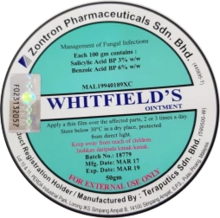Whitfield's ointment

Whitfield's ointment is an acidic ointment used for the topical treatment of dermatophytosis, such as athlete's foot. It can have a slight burning effect that goes away after a few minutes. It is named after Arthur Whitfield (1868–1947), a British dermatologist.[1]
The original ointment contains 3% salicylic acid and 6% benzoic acid in a suitable base, such as lanolin or petrolatum.[2][3] Alternatively, a short-chain alcohol or fatty alcohol can be used as the base.[4]
Whitfield's ointment is not advised for areas of thinner skin, such as the scrotum or the groin, and in such sites should only be used diluted to half-strength.[5]
A systematic review of the medical literature comparing treatments for ringworm and jock itch was generally critical of the quality of data available. It concluded that there was "insufficient evidence to determine if Whitfield's ointment, a widely used agent, is effective",[6] implying that the studies were of poor quality and therefore effectiveness could not be determined. Individual studies support its use as a cost-effective treatment.[7][8][9]
See also
[edit]References
[edit]- ^ Greenwood, David (2008). "8. The poor relations: Fungi and viruses". Antimicrobial Drugs: Chronicle of a twentieth century medical triumph. Oxford University Press. p. 347. ISBN 978-0-19-156007-1.
- ^ "Compound Benzoic Acid Ointment", British Pharmacopoeia, vol. 3, 2009, ISBN 978-0-11-322799-0
- ^ "Benzoic and Salicylic Acids Ointment", United States Pharmacopeia, vol. USP29 – NF24, 2006
- ^ Sauer, Gordon C. (1957-09-01). "Whitfield's Ointment". Archives of Dermatology. 76 (3): 361. doi:10.1001/archderm.1957.01550210087016. ISSN 0003-987X.
- ^ R. J. Hay; H. R. Ashbee (2010), "Mycology", in Tony Burns; et al. (eds.), Rook's Textbook of Dermatology, vol. 2 (8th ed.), Wiley-Blackwell, p. 36.48, ISBN 978-1-4051-6169-5
- ^ El-Gohary, M.; et al. (Aug 4, 2014), "Topical antifungal treatments for tinea cruris and tinea corporis", The Cochrane Database of Systematic Reviews (8): CD009992, doi:10.1002/14651858.CD009992.pub2, PMC 11198340, PMID 25090020
- ^ Gooskens V; et al. (1994). "Treatment of superficial mycoses in the tropics: Whitfield's ointment versus clotrimazole". International Journal of Dermatology. 33 (10): 738–42. doi:10.1111/j.1365-4362.1994.tb01524.x. PMID 8002148.
- ^ Yvonne M. Clayton; Bruce L. Connor (1973), "Comparison of clotrimazole cream, Whitfield's ointment and Nystatin ointment for the topical treatment of ringworm infections, pityriasis versicolor, erythrasma and candidiasis", British Journal of Dermatology, 89 (3): 297–303, doi:10.1111/j.1365-2133.1973.tb02978.x, PMID 4582719
- ^ S. Wright; V. J. Robertson (1986), "An institutional survey of tinea capitis in Harare, Zimbabwe and a trial of miconazole cream versus Whitfield's ointment in its treatment", Clinical and Experimental Dermatology, 11 (4): 371–377, doi:10.1111/j.1365-2230.1986.tb00477.x, PMID 2948740
